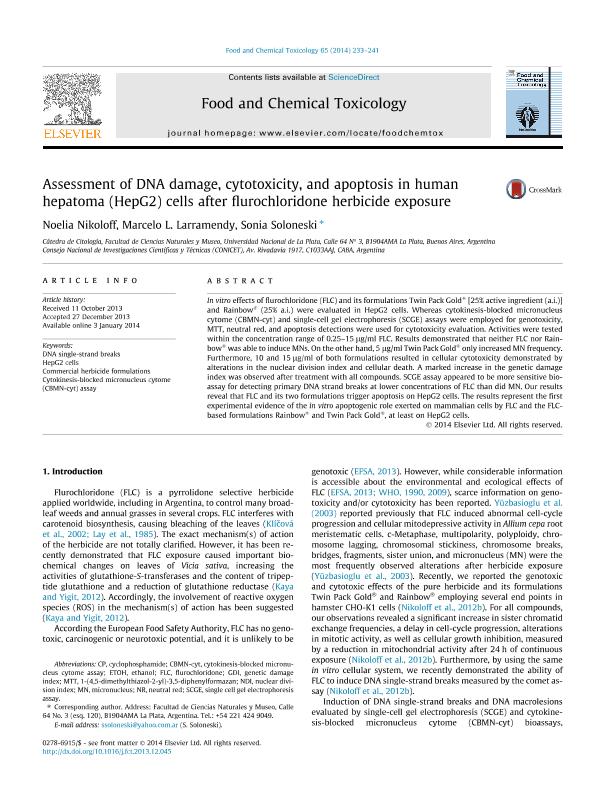Artículo
Assessment of DNA damage, cytotoxicity, and apoptosis in human hepatoma (HepG2) cells after flurochloridone herbicide exposure
Fecha de publicación:
03/2014
Editorial:
Pergamon-Elsevier Science Ltd.
Revista:
Food And Chemical Toxicology
ISSN:
0278-6915
Idioma:
Inglés
Tipo de recurso:
Artículo publicado
Clasificación temática:
Resumen
In vitro effects of flurochloridone (FLC) and its formulations Twin Pack Gold® [25% active ingredient (a.i.)] and Rainbow® (25% a.i.) were evaluated in HepG2 cells. Whereas cytokinesisblocked micronucleus cytome (CBMN-cyt) and single-cell gel electrophoresis (SCGE) assays were employed for genotoxicity, MTT, neutral red, and apoptosis detections were used for cytotoxicity evaluation. Activities were tested within the concentration range of 0.25-15 µg/ml FLC. Results demonstrated that neither FLC nor Rainbow® was able to induce MNs. On the other hand, 5 µg/ml Twin Pack G old® only increased MN frequency. Furthermore, 10 and 15 µg/ml of both formulations resulted in cellular cytotoxicity demonstrated by alterations in the nuclear division index and cellular death. A marked increase in the genetic damage index was observed after treatment with all compounds. SCGE assay appeared to be more sensitive bioassay for detecting primary DNA strand breaks at lower concentrations of FLC than did MN. Our results reveal that FLC and its two formulations trigger apoptosis on HepG2 cells. The results represent the first experimental evidence of the in vitro apoptogenic role exerted on mammalian cells by FLC and the FLC-based formulations Rainbow® and Twin Pack Gold®, at least on HepG2 cells.
Archivos asociados
Licencia
Identificadores
Colecciones
Articulos(CCT - LA PLATA)
Articulos de CTRO.CIENTIFICO TECNOL.CONICET - LA PLATA
Articulos de CTRO.CIENTIFICO TECNOL.CONICET - LA PLATA
Citación
Nikoloff, Noelia; Larramendy, Marcelo Luis; Soloneski, Sonia Maria Elsa; Assessment of DNA damage, cytotoxicity, and apoptosis in human hepatoma (HepG2) cells after flurochloridone herbicide exposure; Pergamon-Elsevier Science Ltd.; Food And Chemical Toxicology; 65; 3-2014; 233-241
Compartir
Altmétricas




